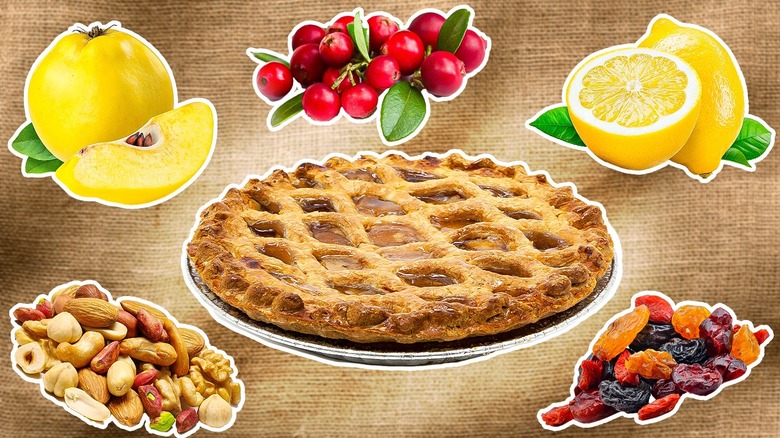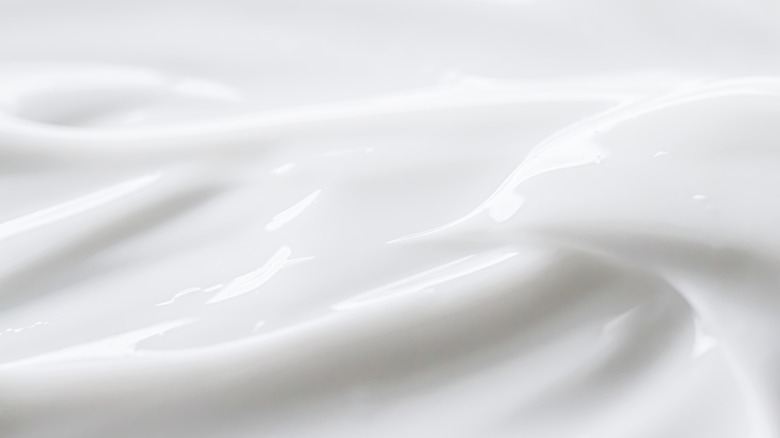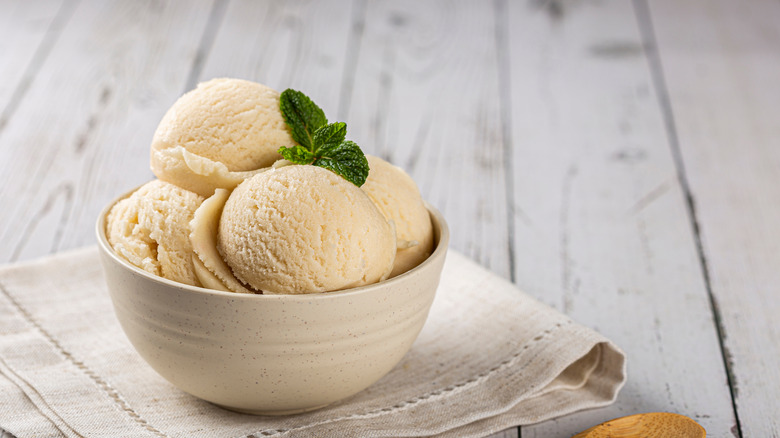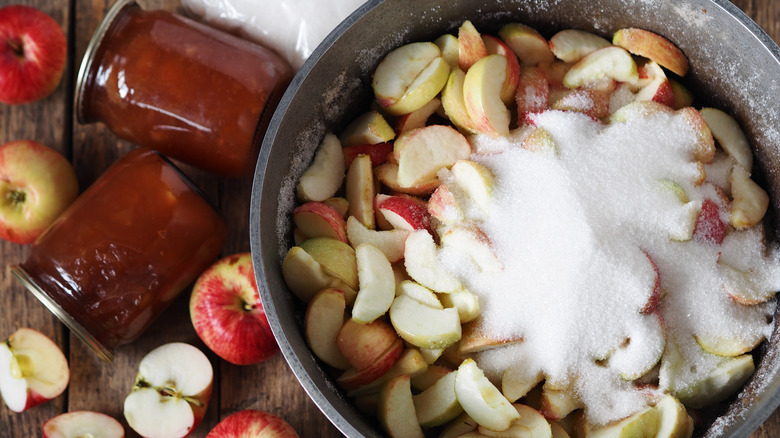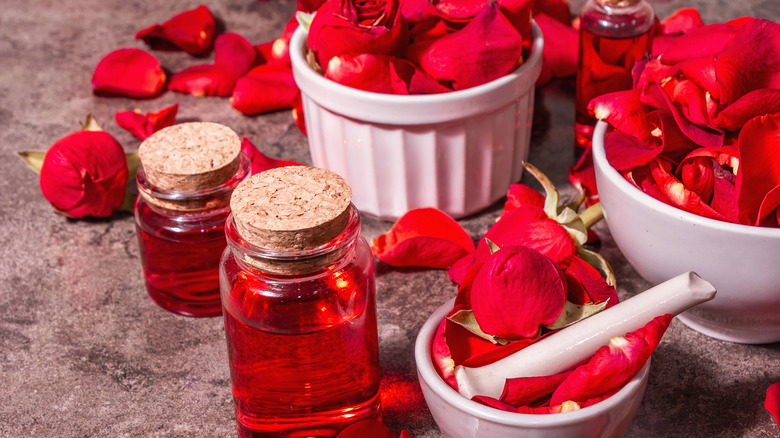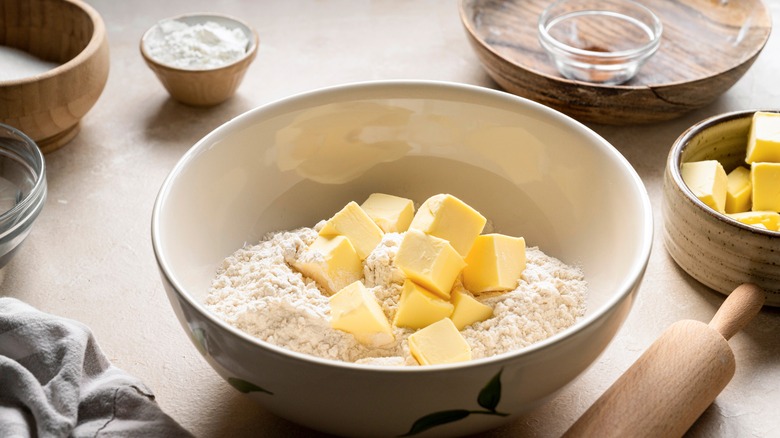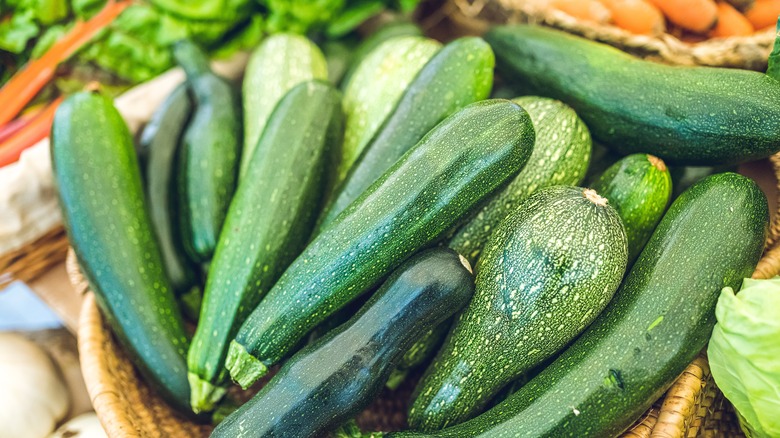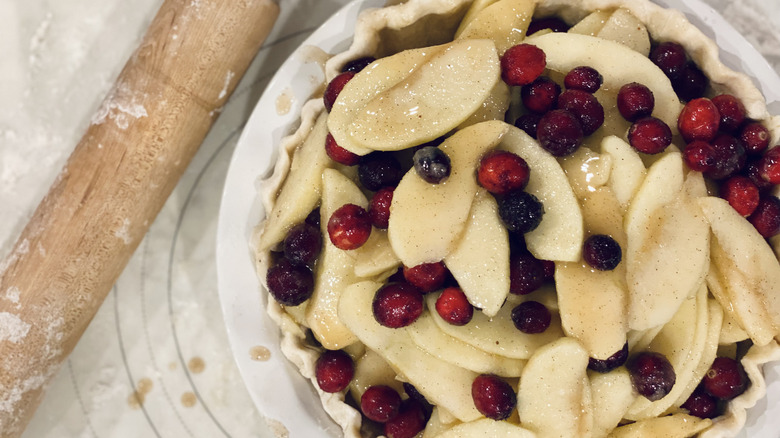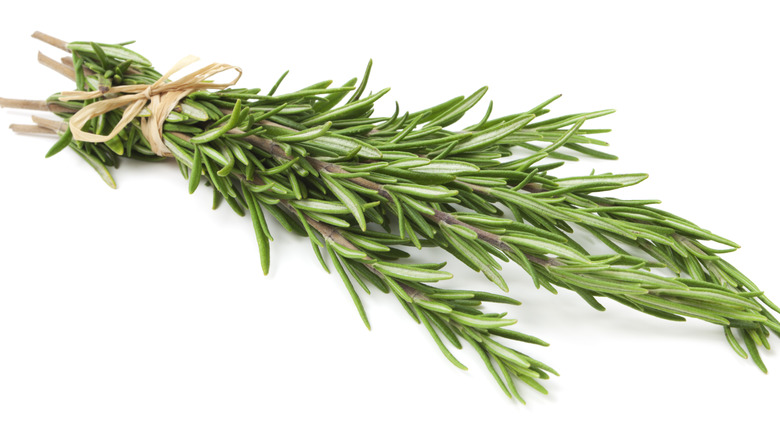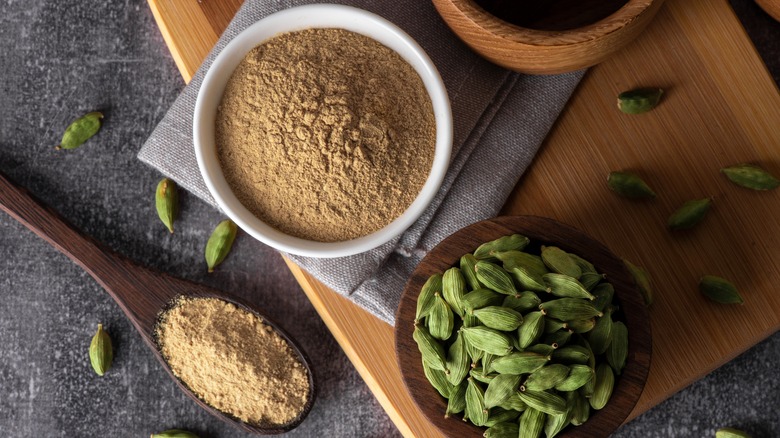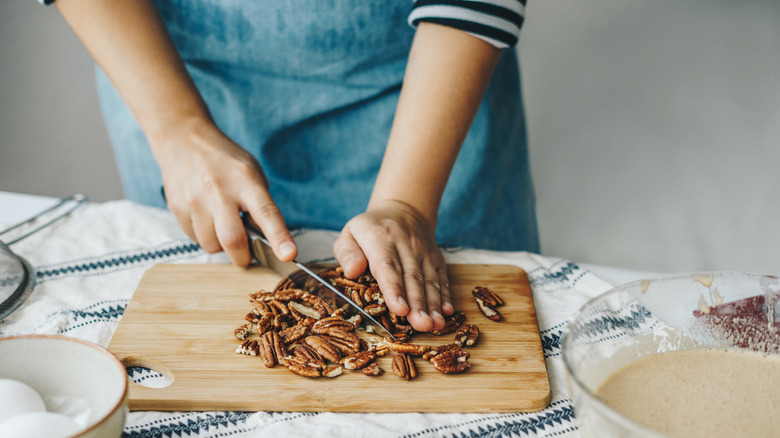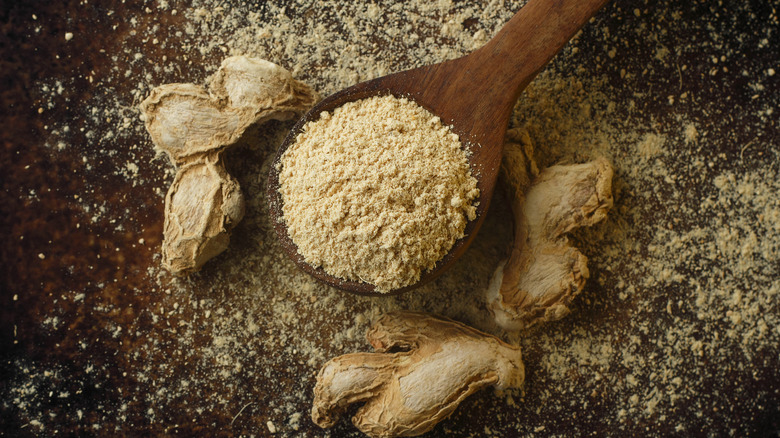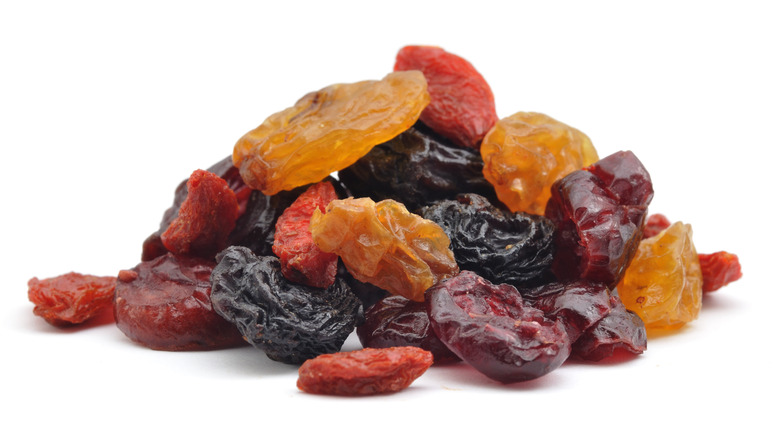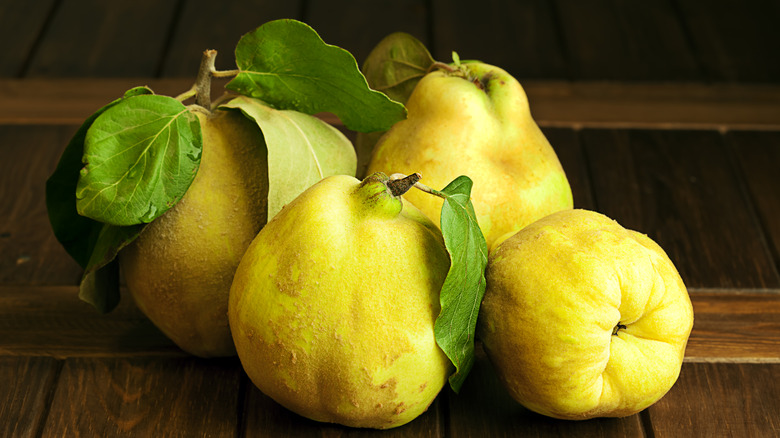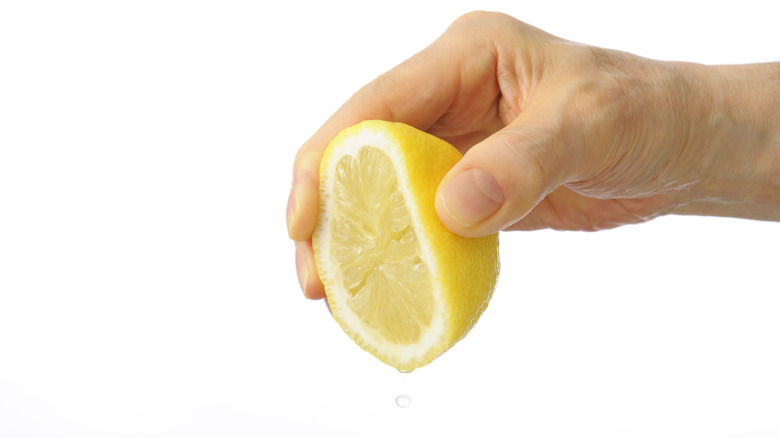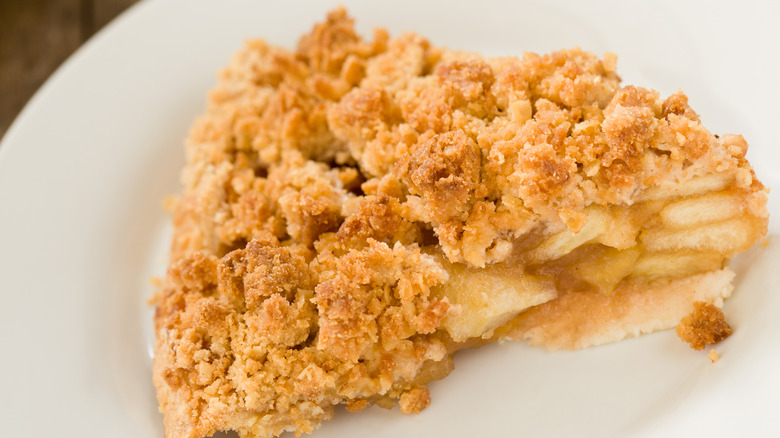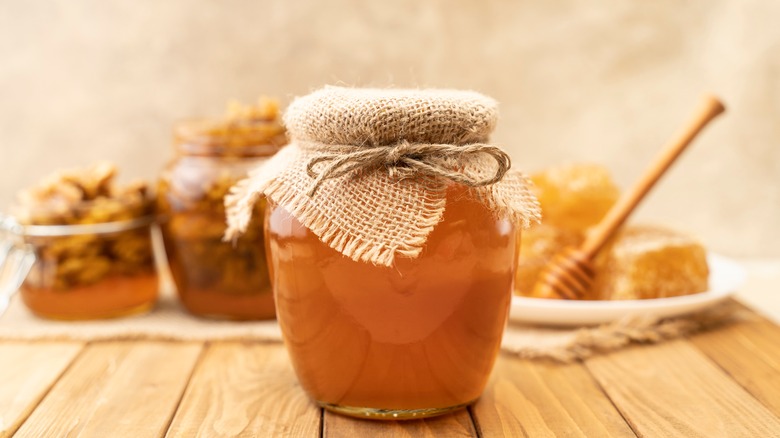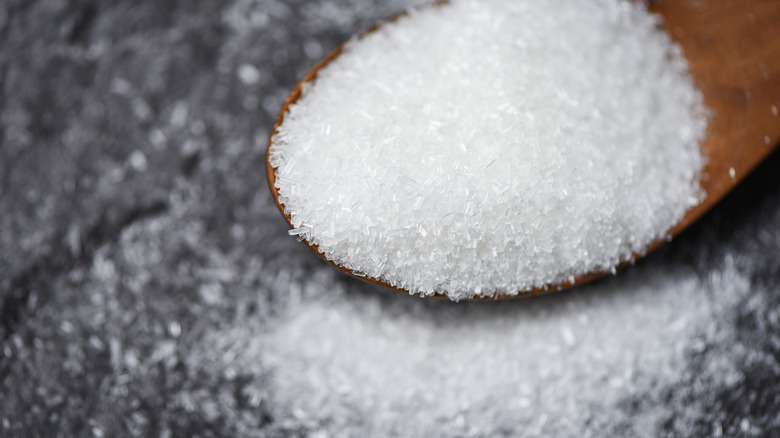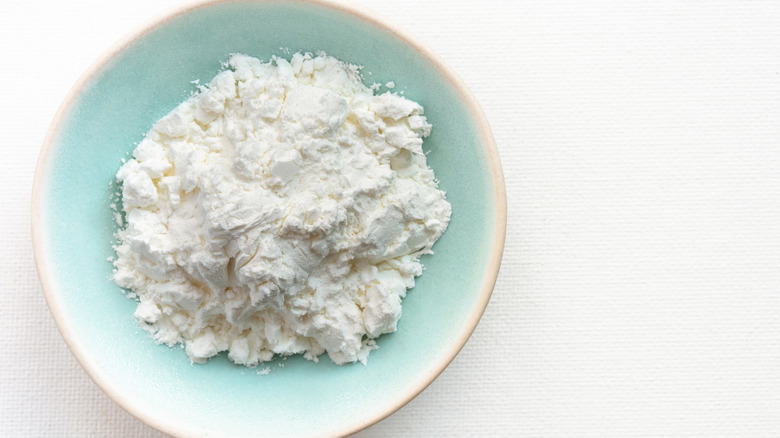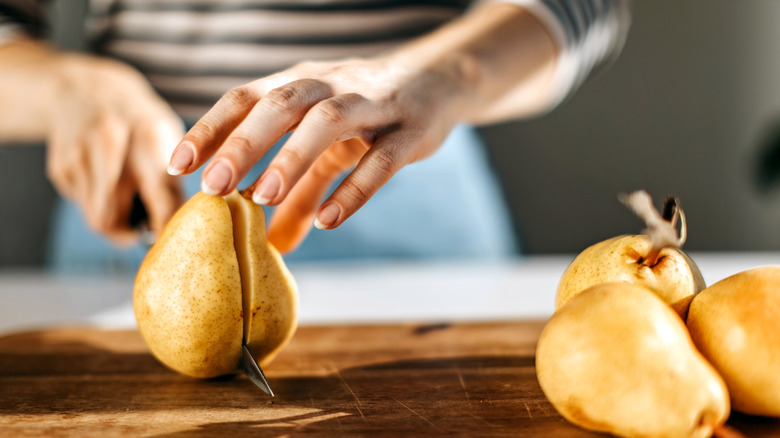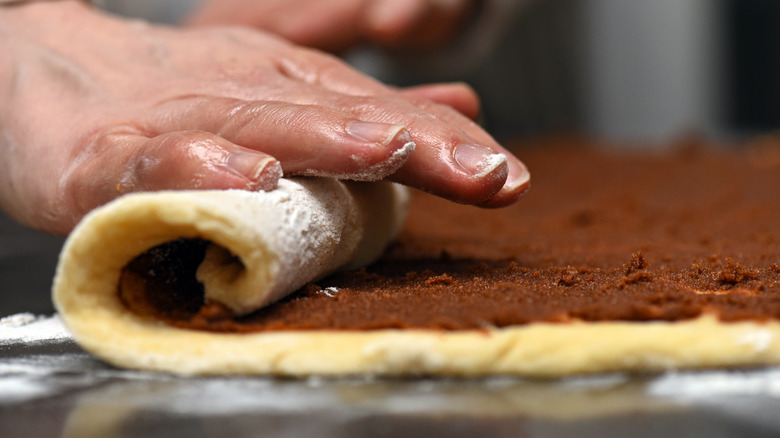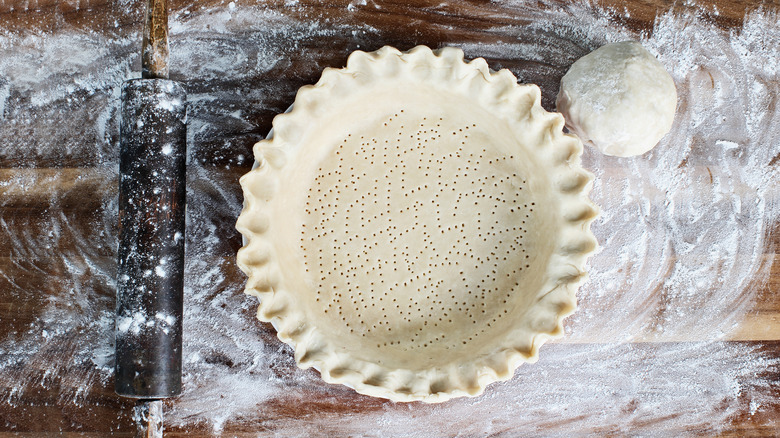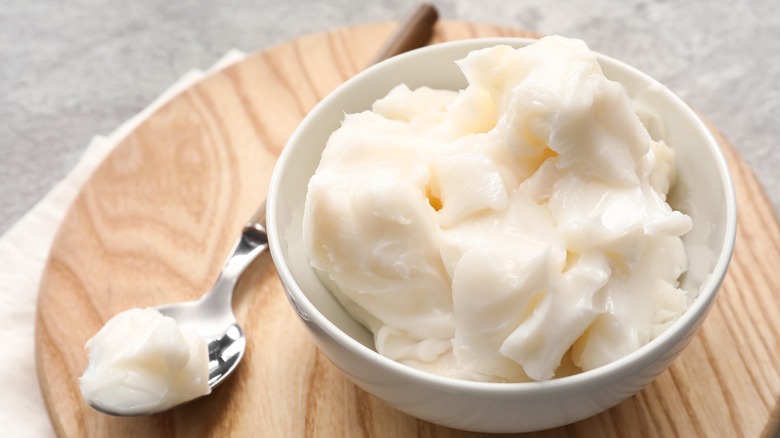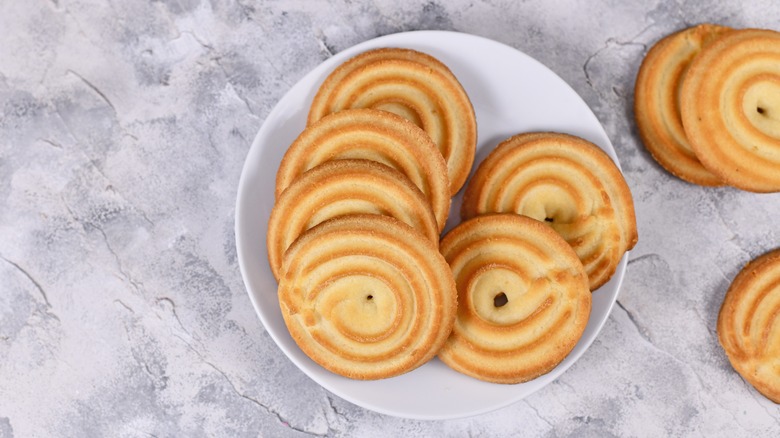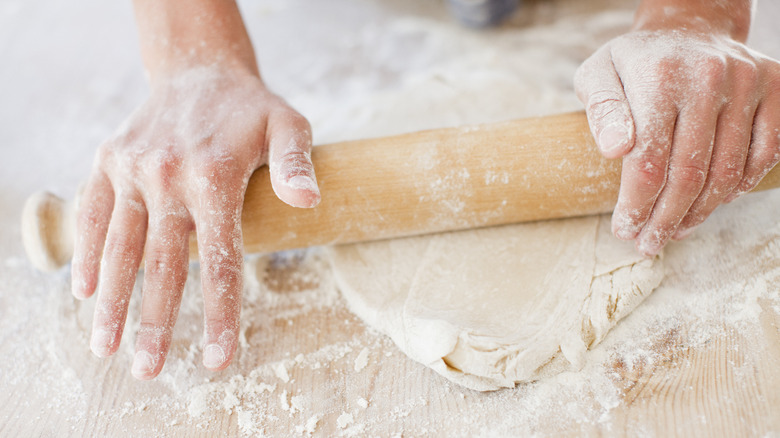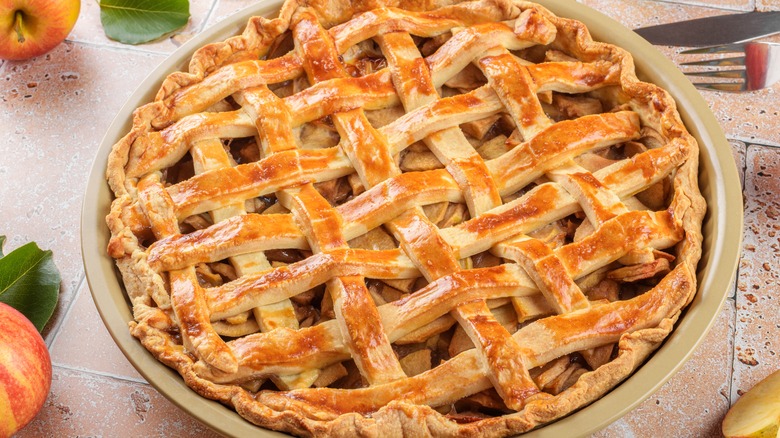25 Ingredients To Elevate Homemade Apple Pie
We can't think of anything much more American than apple pie (well, maybe NASCAR racing or hot dog-eating contests, but you get the point). But the origin of this classic American dessert isn't what you think it is. Apple pie was first made in England as far back as 1381, making the country the first consumer of the beloved dessert. Apple trees didn't arrive on the North American continent until much later, in the 1600s, and the first documented case of Americans eating apple pie didn't even occur until 1697.
Regardless of the true origin of apple pie, we can't argue that it isn't a delicious piece of the American identity. And if you can ask anyone who makes apple pie regularly, you'll probably hear many claims about who makes it best. So while we can't give you a definitive recommendation for the best apple pie recipe, we can provide you with some ways to make your pie a little bit better. Here are some of the best ingredients you can add to spruce up your "all-American" slice.
Add sour cream for a creamy flavor
Sour cream ... that's for baked potatoes! While you may have only heard about sour cream used for savory applications, this versatile ingredient will change your apple pie forever. Since sour cream is composed of a highly fatty and viscous texture, it can make your apple pie filling taste like dulce de leche.
If you add sour cream to your recipe, you'll need about ¼ of a cup per 3 pounds of apples. Mix the sour cream with the apples, lemon juice, thickener, and spices, allowing it to sit for at least an hour for the flavors to meld together.
Marinate your apples in ice cream
Apple pie and ice cream are a match made in heaven, but this ingredient is just usually reserved as a topping for a slice. Adding ice cream to your apple pie filling will majorly upgrade it because it imparts an unmatched custardy vanilla flavor.
The melted vanilla ice cream is substituted for the cream traditionally used in a Dutch apple pie. You'll need to use ½ cup of melted ice cream for every 2½ pounds of apples. The apple and ice cream mixture is left to marinate for about an hour. Then, the entire mixture is added to the pie crust (melted ice cream and all) before being baked. Although vanilla ice cream is an excellent place to start, you can eventually begin to experiment with other flavors like caramel, cinnamon, or maple ice cream.
Use Clear Jel for canning apple pie filling
Canned apple pie filling is an easy way to extend the utility of an excess of apples. To can apples, most people add sliced apples, lemon juice, a sweetener, spices, water, and a thickener like cornstarch or tapioca starch. Unfortunately, these conventional thickeners are not ideal for canned apple pie filling because they tend to stick together, preventing even heat distribution throughout the canning jars. Poor heat distribution comes with many risks, including botulism and foodborne illness.
For thicker home-canned apple pie filling, you should use Clear Jel. This modified cornstarch product does not clump up like regular cornstarch, thus preventing the heat distribution dilemma. You'll need to use regular Clear Jel instead of instant for your filling because you'll be cooking it.
Use rosewater to accentuate your spices
Rosewater is a relatively uncommon ingredient in American recipes, but it is a floral ingredient you should add to your next apple pie. Rosewater is a complementary pairing for the common spices used in apple pie, like cinnamon and nutmeg.
You can make your own rosewater by mixing together organic, food-safe rose petals and water. You can simmer 2 to 3 cups of rose petals (depending on how floral you want your rosewater to be) with ½ gallon of distilled water for about 30 minutes or until the petals start to lose their color. Then, cool and strain the water mixture.
Make a sugar cookie crust
Most apple pie crusts are shortcrusts — meaning that they're made by combining small flecks of butter into flour before baking. While this method is traditional and yields a flaky pie crust (provided your butter doesn't melt and leak out everywhere), there are better ways to make pie crust for your apple pie. One of our favorite hacks is to create a sugar cookie crust instead.
This pie crust is made by creaming the butter and the brown sugar together on high speed before adding the eggs, salt, and flour to the dough. After chilling the dough, it should be pressed into a springform pan. The flavor is just like a warm sugar cookie, with the added texture of the apples.
Introduce some veggies with zucchini
If you're making an apple pie, we can guarantee that one of the last ingredients you'll want to think of adding is a vegetable. But since zucchini has a relatively bland flavor and watery consistency, it's the perfect ingredient to add to an apple pie — or in this case, substitute for the apples. Plus, you can use up all of those extra zucchini at the end of your summer harvest.
To make your zucchini apple pie, you'll need to peel your veggies, scoop out the seeds, and slice the ¼-inch thick half-moon shapes. Then, mix the zucchini with the salt and the lemon juice and sauté to reduce the moisture. Then, mix the zucchini with the remaining sugar and seasonings, add to your pie crust, and bake.
Keep it fruity with cranberries
Apple pies don't have to only contain apples. You can play with different types of fruit to help add a tangy or acidic profile to your pie. One of our favorite ingredients to work with, especially during the fall season, is whole cranberries. The cranberries help tone back some of the overt sweetness of the apples and the sugar while providing a bit of texture and pop of juice.
When you're in the store, look for cranberries that are bright in color and have a floral aroma. You can also use frozen cranberries to make your pie if the fresh variety is not available.
Incorporate savory herbs
Apple pie's staple spices include cinnamon and nutmeg. But there is also some room to play around with other herbs in your pie to help give it a more complex flavor. Rosemary is one of the best herbs you can use for your apple pie. You'll need about 2 teaspoons of fresh rosemary for every 2 pounds (or so) of apples. Be sure to chop your rosemary finely; this will ensure that the savory flavor gets into all of the nooks and crannies of the filling. We recommend pairing the flavor of rosemary with the organic undertone of honey.
Swap out the cinnamon for ground cardamom
Apple pie and cinnamon are very closely linked. But you can explore more than just the world of cinnamon if you try out the cinnamon's close flavor relative: cardamom. Adding cardamom will give your pie an undercurrent of chai — which meshes well with the nutmeg or apple pie spice mix.
There are many ways to add cardamom to your pie. For example, some recipes add ground cardamom to the pie dough while others add the ground spice to the filling. When working with cardamom, it's important to avoid adding too much, as it might upset the precarious balance of flavors.
Add chopped nuts for texture
Apple pie can have a monotonous texture overwhelmed by mushiness. The easiest way to prevent this is to add a crunchy element to your pie.
Nuts are a relatively safe ingredient to add to apple pie because the flavor of the nut is improved when mixed with the sweetness of the apples and the sugar, as well as the warmth of the seasonings. Walnuts are one of the more common nuts added to apple pie, but you can also add pecans instead. You can add the chopped nuts directly to the apple mix; just be sure to finely chop them for an even textural distribution.
Use ginger for a hint of heat
Some apple pie recipes use ginger as an ingredient, but not all of them. You should add ginger to your next apple pie if you like some heat in your sweet baked goods.
The type of ginger used in apple pie recipes varies. Some recipes use ground ginger, which has more of a back-of-the-throat heat, while others recommend grated fresh ginger, which is less dry heat and more of an acidic pop. Be sure to read your recipe to understand what kind of ginger it's calling for since ground ginger and fresh ginger can't be swapped without due care.
Incorporate dried fruits
Dried fruits are the next best thing if you don't have access to fresh fruits to complement your apple pie. There are no exact parameters for what kinds of dried fruit you can add to your pie recipe (except for banana chips — steer clear of those). Popular options include raisins, currants, figs, cranberries, and cherries.
You can add your dried fruits directly to the apple filling; if you are working with large fruits, you may have to dice them up into smaller pieces. If you don't have access to fresh apples, you can also use dehydrated apples that have been mixed with apple juice or cider to bring them back to life.
Utilize quince for some sourness
Have you ever had a quince? If you have, you'll know that these fruits are very floral in aroma and flavor — but also very tough. And since these fruits are so tough, they cook significantly slower than apples.
If you plan to add quince to your apple pie, you'll first need to simmer the quince in juice for about 15 minutes or until they are tender but firm. Then, cut the quince and add it to the filling. Alternatively, you can grate the fresh quince into your pie filling to ensure it cooks at the same rate as the apple slices.
Use lemon or lime juice to prevent browning
Browning — one of the enemies of the apple pie baker. Apples brown after they have been sliced because of oxidation; when the opened cells are exposed to oxygen, an enzyme starts to produce the brown color. While it's harmless to eat brown apples, they look unsightly when mixed into a pie filling.
If you want to counteract browning, add lemon or lime juice to your apples. If you add a tablespoon or two of lemon juice, you won't be able to taste any noticeable difference in flavor. If you're working with a sweet batch of apples, add more lemon juice to help balance out the sweetness.
Make a streusel instead of a standard top crust
Traditional pie crust? Did someone say "boring?" Instead of making a pie crust for the top of your apple pie — which we should add, never seems to brown as well as it should — you should make a streusel instead. Streusel is the fancy name for the topping on apple crisp; it usually includes butter, flour, sugar, cinnamon, and occasionally oatmeal. The streusel is the main difference between Dutch and American apple pie — the former is topped with the streusel, while the latter uses a shortcrust on both the top and the bottom of the pie.
Swap out the sugar for honey or maple syrup
Sugar alternatives have become popular in recent years — both for nutritional and flavor reasons. If you're making an apple pie, you should try to swap out the sugar with a sweetener like honey or maple syrup. Both of these sweeteners have mild, floral, and organic flavors — rather than just the pure sweet taste of sugar.
If you're substituting honey for sugar, you should plan to use ⅔ cup of honey to replace each cup of sugar. If you're making the swap with maple syrup, use ¾ cup of maple syrup for each cup of sugar.
Add MSG for umami flavor
Your Asian seasoning cabinet is probably not the first place you'd think to go for apple pie ingredients, but there is a special one hidden between your soy sauce and fish sauce. You can take your apple pie to the next level by adding monosodium glutamate (MSG) to your pie crust.
The MSG, which is sold in a crystalized form, helps boost the flavor of a buttery crust while also rounding out the sweetness from the pie filling. Therefore, it's essential only to add a little bit of MSG to the pie; too much will throw off the flavor balance and cause your entire pie to taste like fish.
Use a thickener to prevent your apples from getting too runny
Does your apple pie always come out with a soggy bottom? It's likely because your apple filling is too wet, so it sinks down into the delicate crust as the pie bakes. If you want to save your pie from a moist demise, you'll need to add a thickener to your pie filling.
The most common ingredients to thicken the apple filling are cornstarch, tapioca, or plain flour. Some recipes will even call for a bit of instant pudding to help thicken up the filling. Add your thickener to the apple slices, stirring well to ensure that the thickener is well-distributed.
Chop up some pears for the filling
Another fruit you can use to enhance your pie filling is pears. Pears are relatively similar in flavor to apples, but they have a slightly mealier texture and tend to be more moist. Bosc or Bartletts varieties have the most utility when it comes to baking a pie because they are sturdy, juicy, and won't break down in shape when cooked.
You'll want to cook down the pear and apple slices with the sugar, lemon juice, and spices to help remove some of the moisture and prevent the pie from slumping when it bakes.
Make a cinnamon bun crust
Why should you have to pick between your favorite desserts? If you love the ooey-gooey taste of a cinnamon roll, you should try hybridizing it with an apple pie.
You can use the same pie crust dough as the base of the pie — meaning that you don't have to go through the arduous task of proofing and working with yeast dough as you would with traditional cinnamon rolls. Once you've rolled up your cinnamon and sugar pinwheels, flatten them into a single sheet using a rolling pin. Then, you can transfer the pressed cinnamon roll sheet onto the top of the pie, crimp, and bake as normal.
Use crust dust to absorb your crust's moisture
A baker needs numerous ingredients in their toolkit to prevent a soggy bottom. Crust dust is the magic dust that's a game-changer for your pie crust because it will absorb all of the extra drippings and moisture from your pie filling.
If you're a baker, you likely already have all of the ingredients you need to make your powder — it's just a 50-50 ratio of sugar and flour. These ingredients will absorb the excess moisture as your pie bakes, and you'll only need about 2 teaspoons for a standard pie. Line the entire pie with the dust before adding your filling for a final product free of a soggy bottom.
Add lard for a flaky crust
Most bakers have a tried-and-true pie crust recipe that they'll use for everything. Some crusts contain a mixture of butter and shortening, while others opt for a purely buttery baking experience. We think the best fat to add to your apple pie, though, is lard.
Lard can help your pie crust by making it super flaky and soft. Plus, the fruity flavor of the apples can help ward off any porky flavor. We recommend using a blend of both flour and lard in your pie crust to help develop the perfect color and flavor.
Chop up some shortbread cookies
We don't blame you if you opt to use a store-bought pie crust for your apple pie-baking adventures. After all, you just have to fill it and bake it — without worrying about ripping, tearing, or sticking. But the major drawback to using store-bought pie crust is that the flavor can be a bit bland.
The simple way to elevate the flavor of store-bought pie crust is to crumble up shortbread cookies to both prevent the crust from drying out and to add a bit of buttery flavor. Crumble up shortbread cookies into a fine powder before pressing the crumbs into your pie crust. You can also add a brush of melted butter to the crust to help seal in more moisture before you scoop in your apple filling.
Incorporate more than just white flour
Most pie crust recipes call for a standard all-purpose white flour. But there is a world of opportunities besides just this flour type. You should try a blend of different flours for your pie crust to help enhance its flavor and its texture. One of our favorite combinations of flours to use for apple pie is a blend of all-purpose flour and whole wheat flour. You'll get a slightly rustic, nutty flavor from the whole wheat flour without altering the crust's texture too much. If you prefer a delicate crust with a soft taste, try adding a bit of pastry flour to your all-purpose flour.
Substitute some of the butter with suet
Suet ... isn't that what birds eat? Indeed, suet is a dry, crumbled fat sourced from around the kidneys of animals. Unlike other types of fats, suet has a crumbly texture that makes it less greasy than butter or lard when added to a pie. You should consider adding suet to your next pie crust because it has a high melting point, making the dough more difficult to overwork. If you add suet to a sweet pie, like an apple, you should blend butter and suet for the perfect flavor and texture.
